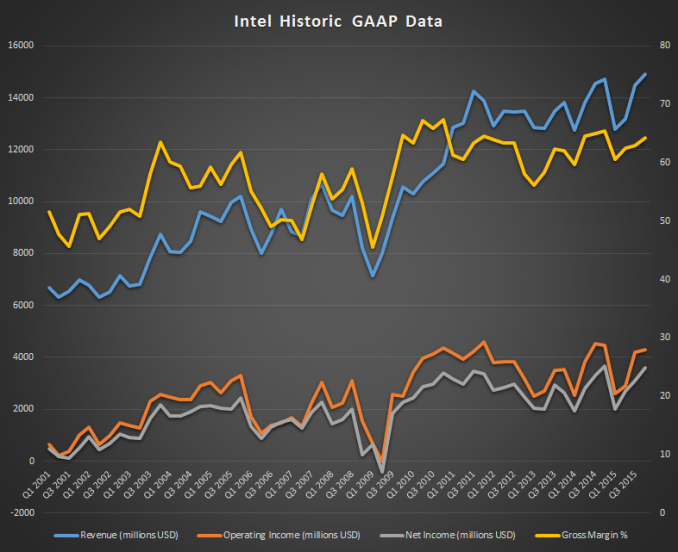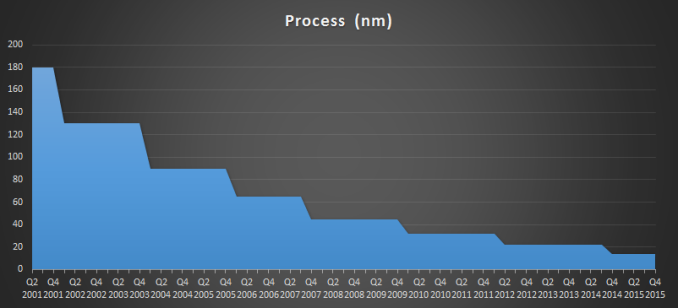Intel Reports Q4 FY 2015 Results: Record Revenue For Q4
by Brett Howse on January 14, 2016 10:00 PM EST- Posted in
- CPUs
- Intel
- Financial Results

Today Intel announced their earnings for the fourth quarter of fiscal year 2015. The year ended strong, with record revenues of $14.9 billion. This is up 1% of Q4 of 2014, and up 3% over last quarter. Intel’s margins did drop a 1.1%, but are still a healthy 64.3% for the quarter. Operating income for the last quarter of the year was $4.3 billion, and net income came in at $3.6 billion. These results are down 3$ and 1% respectively, compared to Q4 of 2014. Earnings per share was flat at $0.74 per share.
For the full fiscal year 2015, revenues were $55.4 billion, which is down 1% compared to 2014. Gross margin was down 1.1% to 62.6% for the year. Operating income was $14.0 billion, down 9% compared to 2014, and net income was down 2% to $11.4 billion.
| Intel Q4 2015 Financial Results (GAAP) | |||||
| Q4'2015 | Q3'2015 | Q4'2014 | |||
| Revenue | $14.9B | $14.5B | $14.7B | ||
| Operating Income | $4.3B | $4.2B | $4.4B | ||
| Net Income | $3.6B | $3.1B | $3.6B | ||
| Gross Margin | 64.3% | 63.0% | 65.4% | ||
| Client Computing Group Revenue | $8.8B | +3% | -1% | ||
| Data Center Group Revenue | $4.3B | +4% | +5% | ||
| Internet of Things Revenue | $625M | +8% | +6% | ||
| Software and Services Revenue | $543M | -2% | -3% | ||
| All Other Revenue | $682M | flat | +11% | ||
For the full year, Intel’s largest division, the Client Computing Group, was down 8% in revenue to $32.2 billion, but for Q4 2015 the group was down just 1% year-over-year. Intel is currently shipping 14 nm parts based on Skylake, and as of November, 14 nm parts made up over 50% of the Client Computing Group’s unit sales. The move to 14 nm has been pretty slow by Intel’s standards, and even many of the Skylake chips are in short supply still, but Intel did say that yields have improved to the point where they feel they have an oversupply at the moment so hopefully some of the high demand parts find their way to retailers for stock. With the drop in the overall PC market, it’s not too surprising that this group has dropped, but although total device numbers have dropped, average selling price has increased.
Intel’s record revenue came from the Data Center group, which had record revenue for FY 2015 of $16.0 billion, up 11% compared to 2014. For the quarter, Data Center revenue grew 5% year-over-year to $4.3 billion. The move to cloud computing is going to drive some growth here, and offset some of the weakness in the PC market for companies like Intel. Margins are generally better in this group, so it is less difficult to offset the PC drop with a high margin area like Data Center. Intel is pretty much unchallenged in this space for a lot of computing needs, at least at the moment. There was some struggle in China's market, but the overall market was enough to overcome this.
Internet of Things also had record revenue for the fiscal year. For FY 2015, this segment’s revenue was up 7% to $2.3 billion. It’s still pretty small potatoes compared to the other segments of Intel, but this is one area where they are keen to not fall behind ARM like they did in the mobile space. There is a lot of room for growth here, although it’s going to be at a much lower margin than Intel is accustomed to. For Q4, this division grew 6% year-over-year to $625 million.
Software and Services, which consists of products like McAfee Antivirus, was down 2% for the full year to $2.2 billion. For Q4, revenues were down 3% compared to Q4 2014, coming in at $543 million.
The final segment is Non-Volatile Memory Solutions, and for 2015 this segment had record full-year revenue, up 21% compared to 2014. Unfortunately, Intel does not break this out individually, but it on the conference call they announced revenues of $2.6 billion for FY 2015. Intel announced their 3D X-Point memory, and shipments should start later this year.
For the full year, Intel paid $7.6 billion back to shareholders, with $4.6 billion in dividends and $3.0 billion used to repurchase stock. Intel has announced an increase in dividends to $1.04-per-share on an annual basis.
Intel also announced that they have completed the acquisition of Altera and they took on about $9.5 billion in debt to finance this.
Looking towards FY 2016, Intel is expecting mid to high single digit revenue growth as a percentage compared to 2015, which is an increase over their guidance issued in November. This increase is being attributed to the FPGA business which they have just acquired through Altera. Gross margin is expected to be 63%.
Source: Intel Investor Relations












20 Comments
View All Comments
iwod - Friday, January 15, 2016 - link
After all this years i still wonder why Intel bought McAfee.....Aspiring Techie - Friday, January 15, 2016 - link
Especially since McAfee doesn't have the same quality that all other Intel products have...Michael Bay - Sunday, January 17, 2016 - link
Maybe it was done as a means to an end scenario. Buy this and we give you access to that.jjj - Friday, January 15, 2016 - link
Hilarious how many times you use the term "record", nobody objective would do so."Intel’s margins did drop a 1.1%, but are still a healthy 64.3% for the quarter" - you should have been specific is it's on year or on quarter, it is on year.
Funny how you avoid units data and ASP data, things that might make Intel look bad.
"14 nm parts made up over 50% of the Client Computing Group’s revenue." - that's units not revenue and a big chunk of that are Atom, Intel is trying to mislead since most will read it like you did instead of seeing through it.
Nfarce - Tuesday, January 19, 2016 - link
Hate to burst your bubble, AMD snowflake, but record revenue is RECORD REVENUE. It cannot be sliced, diced, or spun. RECORD REVENUE. Deal with it accordingly. Maybe if AMD would get off their bums and actually make COMPETITIVE CHIPS to AMD, some of that would have been chipped away hate. Don't hate Intel for doing it better...people buy what is best for their money. AMD is on the losing end of that...for now.just4U - Tuesday, January 19, 2016 - link
Amd made better chips at one point and that still didn't help them... Intel still dominated with "record" sales.. Let's just face facts shall we?Unless AMD comes up with something that's at least 2x better than what Intel has on the table.. (maybe even 3x) it's not going to translate into hurting Intel sales. Hell.. they've had comparable products to Nvidia yet Nvidia has 80% of the market share.
r3loaded - Friday, January 15, 2016 - link
Slump in PC industry sales but client computing group revenue still increases. Clearly, they're squeezing as much out of Skylake's inflated price as possible before AMD's Zen lands.eanazag - Friday, January 15, 2016 - link
Intel is not worried about Zen.D. Lister - Saturday, January 16, 2016 - link
"Clearly, they're squeezing as much out of Skylake's inflated price as possible before AMD's Zen lands."ROFL, yeah clearly.
mapesdhs - Friday, January 15, 2016 - link
IMO the PC slump is partly Intel's own making. "Build it and they will come." They haven't made an enthusiast range of CPUs genuinely worth buying since SandyBridge, and for consumers it's the top-end where the real margins are; many highstreet stores survive on premium parts (only big vendors can make useful money on budget parts by pushing volume). This is just like the hifi market, luxury cars, phones, TVs, etc. - companies bring out newer models that are indeed worth buying. In PC tech, storage devices and GPUs have evolved nicely, but Intel's CPUs have not.This isn't just my opinion, plenty of review sites have said the same thing in recent years, eg. toms' 2013 headline, "Haswell Is Faster; Desktop Enthusiasts Yawn".Still today there are numerous forum comments from SandyBridge owners who continue to see little reason to upgrade (indeed, I've seen similar comments even from X58 owners). Intel needs to reboot the enthusiast market with something that's demonstrably worth the cost at enthusiast each price point, or based on significantly better performance, or both, eg. 840 UKP for an oc'd HW-E 8-core that's only 40% faster than a 3970X/4.8 is not remotely worth it. We need a 10/12-core desktop part, unlocked XEON, unlocked i3, *something*. SkyLake is too expensive, HW-E isn't good enough, so people aren't buying. G3258 was interesting but ultimately underwhelming with its lackof HT. This all has knock-on effects, ie. fewer sales means less exposure to PC tech in the first place, so yet more people adopt tablets and phones. My neighbour is soon to switch to all-tablets for his family, so his new daughter will grow up not knowing about PC tech.
Meanwhile, as consumers move to expecting suitable systems for handling 4K video, they're going to find main CPU power distinctly lacking, a gap that can be jumped on by GPU vendors for relevant applications.
I just don't get why Intel is perfectly capable of releasing something suitable for the enthusiast market in a manner which would certainly sell, but doesn't, and meanwhile sales keep declining.
Forums are full of people pinning their hopes on Zen forcing Intel to back into the game. I certainly hope so. Maybe even Intel fans should buy a Zen aswell purely as a way of helping encourage Intel to get a move on. We clearly need the competition.